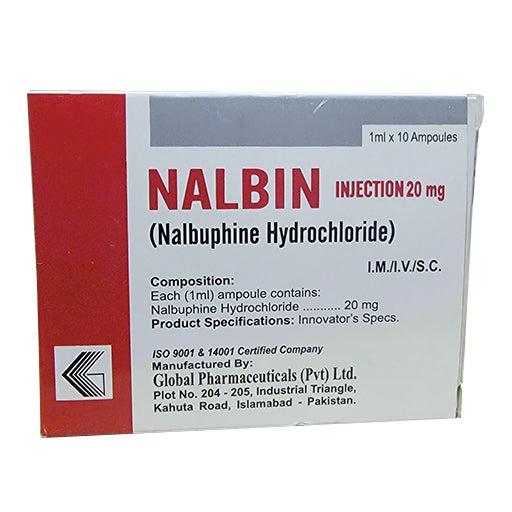Your cart is currently empty.
Nalbin 20 mg/mL Injection (Nalbuphine Hydrochloride) – Pack of 10 Ampoules
: Available:
QUESTIONS & ANSWERS
Have a Question?
Be the first to ask a question about this.
Category:

Description
Nalbin Injection contains Nalbuphine Hydrochloride, a synthetic opioid analgesic with agonist–antagonist activity. It provides effective relief for moderate to severe pain and is often used in postoperative pain management, labor pain, and trauma-related pain. Compared to pure opioids, Nalbin has a lower risk of respiratory depression, though caution is still required.
Ingredients
-
Active Ingredient: Nalbuphine Hydrochloride 20 mg per mL
-
Excipients: Sterile water for injection and stabilizers (per manufacturer’s formula)
Drug Class
-
Opioid Analgesic (Agonist–Antagonist)
Dosage Form
-
Injection
-
Strength: 20 mg/mL
-
Pack: 10 Ampoules
Uses / Indications
-
Moderate to severe acute pain
-
Postoperative pain relief
-
Pain during labor and delivery
-
Supplement to anesthesia (pre-, intra-, or postoperative)
-
Pain management in myocardial infarction and trauma cases
Dosage
-
Adults:
-
10–20 mg every 3–6 hours as needed
-
Maximum daily dose: 160 mg
-
-
Children (>18 months): 0.2–0.3 mg/kg every 3–4 hours (not to exceed 2.5 mg/kg/day)
-
Routes: IV (intravenous), IM (intramuscular), or SC (subcutaneous)
-
Dosage must be individualized according to pain severity and patient’s response
In Case of Overdose
-
Symptoms: Respiratory depression, sedation, hypotension, coma
-
Treatment:
-
Ensure airway patency, provide ventilatory support
-
Administer naloxone (opioid antagonist)
-
Symptomatic and supportive care
-
Missed Dose
-
Nalbin is usually hospital-administered; missed doses are rare
-
If self-administered, never double dose — resume as per schedule with doctor’s advice
How To Use / Administration Instructions
-
Administer by IV, IM, or SC injection under medical supervision.
-
Inspect ampoule before use; solution should be clear.
-
Inject IV doses slowly to reduce risk of side effects.
-
Only healthcare professionals should prepare and administer.
When Not to Use / Contraindications
-
Allergy to nalbuphine or other opioids
-
Patients with respiratory depression not under monitoring
-
Acute/severe asthma without access to resuscitation
-
Concomitant use with opioid agonists (e.g., morphine, methadone) in dependent patients – may cause withdrawal
-
Use cautiously in head injury, raised intracranial pressure, or reduced consciousness
Side Effects / Adverse Reactions
Common:
-
Drowsiness, dizziness, headache
-
Nausea, vomiting, dry mouth
-
Sweating, flushing, injection site pain
Serious (rare):
-
Respiratory depression
-
Bradycardia, hypotension
-
Allergic reactions (rash, itching, swelling, anaphylaxis)
-
Dependence with prolonged use
Precautions & Warnings
-
Use cautiously in renal or hepatic impairment
-
Avoid alcohol and sedative drugs during therapy
-
May impair alertness — avoid driving or operating heavy machinery
-
Pregnancy: crosses placenta — may cause newborn respiratory depression
-
Breastfeeding: passes into breast milk; use cautiously
-
Monitor elderly patients closely
Drug Interactions
-
CNS depressants (alcohol, benzodiazepines, sedatives): ↑ risk of sedation/respiratory depression
-
Other opioids (morphine, fentanyl, methadone): withdrawal risk in dependent patients
-
MAO inhibitors, antidepressants, antipsychotics: additive CNS effects
-
Anesthetics and muscle relaxants: enhanced respiratory depression
Storage / Disposal
-
Store below 25°C
-
Protect from light and freezing
-
Keep in original ampoule packaging until use
-
Discard unused contents safely via medical waste protocols
-
Keep out of children’s reach
Control Drug / Prescription Status
-
Prescription-only controlled medicine
-
Restricted to use under physician supervision in healthcare settings
Quick Tips
-
Nalbin may cause drowsiness — avoid driving or handling machinery
-
Do not consume alcohol while using this injection
-
Always use the lowest effective dose for the shortest duration
-
Inform your doctor about any other medications you are taking
-
Report breathing problems or severe dizziness immediately
Your order of 100$ or more gets free standard delivery.
- Standard delivered 4-5 Business Days
- Express delivered 2-4 Business Days
Orders are processed and delivered Monday-Friday (excluding public holidays)
eMarket members enjoy free returns.
Related Products

Categories
Custom HTML Text
-
Free Delivery
From Rs 5000
-
Support 24/7
Online 24 hours
-
Free return
365 a day
- Choosing a selection results in a full page refresh.
Added to cart successfully. What's next?

Product type: 1
1 x $00.00






















 Chat with Us
Chat with Us